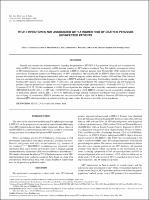HTLV- I infection is not associated with a higher risk of death in peruvian HIV- infected patients
Related Resource(s)
https://www.scielo.br/j/rimtsp/a/ndbJmRSDckPYN5qXk5VrnPp/?lang=enDate
2009Author(s)
Collins, Jaime A.
Hernández, Adrián V.
Hidalgo, José A.
Salazar, Raúl
Almenara Hospital AIDS Working Group
Metadata
Show full item recordAbstract
Existe información limitada y contradictoria sobre el pronóstico de la coinfección del Virus de Inmunodeficiencia Humana (VIH) y el Virus Linfotrópico T Humano tipo 1 (HTLV-1), por este motivo se realizó un estudio para estimar el efecto de la infección por HTLV-1 en la mortalidad de pacientes infectados con VIH en la Unidad de VIH/SIDA del Hospital Nacional Guillermo Almenara, en Lima, Perú. Se estudió una cohorte retrospectiva de pacientes infectados por el VIH, que estuvieron expuestos o no al HTLV-1, entre enero 1990 a junio 2004. El estudio concluye que la infección de HTLV-1 no estaba asociada con un riesgo alto de muerte de pacientes peruanos infectados con el virus de VIH. El exceso de mortalidad en esta población se puede explicar con la infección avanzada de VIH y la ausencia de terapia antirretroviral. Limited and contradictory information exists regarding the prognosis of HIV/HTLV-I co-infection. Our goal was to estimate the effect of HTLV-I infection on mortality in HIV-infected patients at a HIV reference center in Peru. We studied a retrospective cohort of HIV-infected patients, who were exposed or unexposed to HTLV-I. Exposed patients were Western Blot (WB) positive for both retroviruses. Unexposed patients were WB positive for HIV, and had least one negative EIA for HTLV-I. These were selected among patients who entered our Program immediately before and after each exposed patient, between January 1990 and June 2004. Survival time was considered between the diagnosis of exposure to HTLV-I and death or censoring. Confounding variables were age, gender, baseline HIV clinical stage, baseline CD4+ T cell count, and antiretroviral therapy. We studied 50 exposed, and 100 unexposed patients. Exposed patients had a shorter survival compared to unexposed patients [median survival: 47 months (95% CI: 17-77) vs. 85 months (95% CI: 70-100), unadjusted p = 0.06]. Exposed patients had a higher rate of mortality compared to unexposed patients (HIV/HTLV-I (24/50 [48%]) vs. HIV only (37/100 [37%]), univariable p = 0.2]. HTLV-I exposure was not associated to a higher risk of death in the adjusted analysis: HR: 1.2 (0.4-3.5). AIDS clinical stage and lack of antiretroviral therapy were associated to a higher risk of dying. In conclusions, HTLV-I infection was not associated with a higher risk of death in Peruvian HIV-infected patients. Advanced HIV infection and lack of antiretroviral therapy may explain the excess of mortality in this population.
Collections
- Artículos científicos [890]






